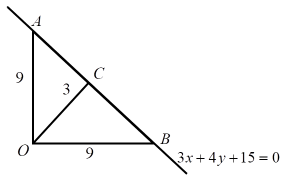
If $A$ and $B$ are two points on the line $3x + 4y + 15 = 0$ such that $OA = OB = 9$ units, then the area of the triangle $OAB$ is
A. $18$ sq. units
B. $18\sqrt 2 $ sq. units
C. $\dfrac{{18}}{{\sqrt 2 }}$ sq. units
D. None of these
Answer
216.6k+ views
Hint: In this question, we are given the equation of a line and the distance of two points on the line from the origin. To find the area of the triangle, we will find the perpendicular distance of the line from the origin, further, we will find the base of the triangle using the Pythagoras theorem.
Complete step by step solution:
We are given two points $A$ and $B$ lying on the line $3x + 4y + 15 = 0$, and we are given that distance of point $A$ from the origin is $OA = 9$ units and the distance of point $B$ from the origin is also $9$ units. Thus, a triangle $OAB$ is formed with sides $OA, OB, AB$. To find the area of this triangle, we need to know the measure of the height of the triangle and the base of the triangle.
We know that the perpendicular distance of a line $ax + by + c = 0$ from the origin is given as $d = \dfrac{c}{{\sqrt {{a^2} + {b^2}} }}$
Perpendicular distance of the line $3x + 4y + 15 = 0$ from the origin is:
$
d = \dfrac{{15}}{{\sqrt {{{(3)}^2} + {{(4)}^2}} }} \\
\Rightarrow d = \dfrac{{15}}{5} \\
\Rightarrow d = 3 \\
$
Thus, the height of the triangle is $3$ units.

Image: Diagram of the triangle OAB
In the above diagram, the perpendicular distance of the given line from the origin is given by $OC$
, it bisects the given line and makes C the midpoint of the line.
We also know $OA = OB = 9$ units, so applying the Pythagoras theorem, we get:
$
AB = 2AC = 2\sqrt {{{(9)}^2} - {{(3)}^2}} \\
\Rightarrow AB = 12\sqrt 2 \\
$
Thus, the base of the triangle is $12\sqrt 2 $ units.
$
Area = \dfrac{1}{2} \times base \times height \\
\Rightarrow Area = \dfrac{1}{2} \times 3 \times 12\sqrt 2 \\
\Rightarrow Area = 18\sqrt 2 \\
$
Thus, the area of the triangle $OAB$ is $18\sqrt 2 $ sq. units.
The correct option is option B.
Note: As the origin is one of the vertices of the triangle $OAB$ and the other two points $A, B$ lie on the line $3x + 4y + 15 = 0$, the perpendicular distance of the line from the origin is actually its height and bisects $AB$, that’s why C is the midpoint.
Complete step by step solution:
We are given two points $A$ and $B$ lying on the line $3x + 4y + 15 = 0$, and we are given that distance of point $A$ from the origin is $OA = 9$ units and the distance of point $B$ from the origin is also $9$ units. Thus, a triangle $OAB$ is formed with sides $OA, OB, AB$. To find the area of this triangle, we need to know the measure of the height of the triangle and the base of the triangle.
We know that the perpendicular distance of a line $ax + by + c = 0$ from the origin is given as $d = \dfrac{c}{{\sqrt {{a^2} + {b^2}} }}$
Perpendicular distance of the line $3x + 4y + 15 = 0$ from the origin is:
$
d = \dfrac{{15}}{{\sqrt {{{(3)}^2} + {{(4)}^2}} }} \\
\Rightarrow d = \dfrac{{15}}{5} \\
\Rightarrow d = 3 \\
$
Thus, the height of the triangle is $3$ units.

Image: Diagram of the triangle OAB
In the above diagram, the perpendicular distance of the given line from the origin is given by $OC$
, it bisects the given line and makes C the midpoint of the line.
We also know $OA = OB = 9$ units, so applying the Pythagoras theorem, we get:
$
AB = 2AC = 2\sqrt {{{(9)}^2} - {{(3)}^2}} \\
\Rightarrow AB = 12\sqrt 2 \\
$
Thus, the base of the triangle is $12\sqrt 2 $ units.
$
Area = \dfrac{1}{2} \times base \times height \\
\Rightarrow Area = \dfrac{1}{2} \times 3 \times 12\sqrt 2 \\
\Rightarrow Area = 18\sqrt 2 \\
$
Thus, the area of the triangle $OAB$ is $18\sqrt 2 $ sq. units.
The correct option is option B.
Note: As the origin is one of the vertices of the triangle $OAB$ and the other two points $A, B$ lie on the line $3x + 4y + 15 = 0$, the perpendicular distance of the line from the origin is actually its height and bisects $AB$, that’s why C is the midpoint.
Recently Updated Pages
JEE Atomic Structure and Chemical Bonding important Concepts and Tips

JEE Amino Acids and Peptides Important Concepts and Tips for Exam Preparation

Electricity and Magnetism Explained: Key Concepts & Applications

Chemical Properties of Hydrogen - Important Concepts for JEE Exam Preparation

JEE Energetics Important Concepts and Tips for Exam Preparation

JEE Isolation, Preparation and Properties of Non-metals Important Concepts and Tips for Exam Preparation

Trending doubts
JEE Main 2026: Application Form Open, Exam Dates, Syllabus, Eligibility & Question Papers

Derivation of Equation of Trajectory Explained for Students

Hybridisation in Chemistry – Concept, Types & Applications

Understanding the Angle of Deviation in a Prism

Understanding Collisions: Types and Examples for Students

How to Convert a Galvanometer into an Ammeter or Voltmeter

Other Pages
JEE Advanced Marks vs Ranks 2025: Understanding Category-wise Qualifying Marks and Previous Year Cut-offs

NCERT Solutions for Class 11 Maths Chapter 10 Conic Sections

NCERT Solutions for Class 11 Maths Chapter 9 Straight Lines

NCERT Solutions For Class 11 Maths Chapter 8 Sequences And Series

Understanding Atomic Structure for Beginners

NCERT Solutions For Class 11 Maths Chapter 12 Limits And Derivatives




